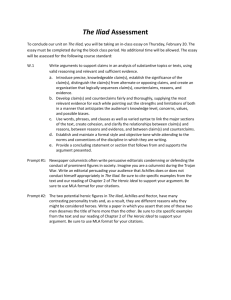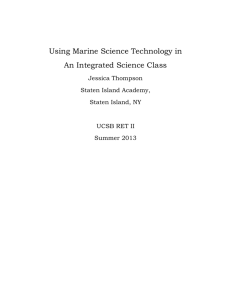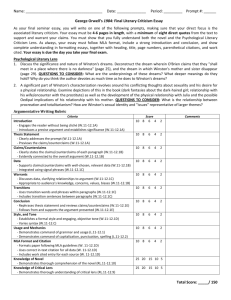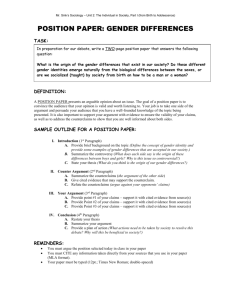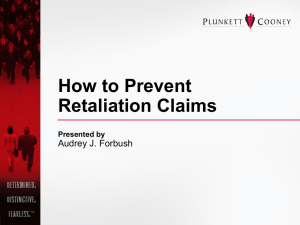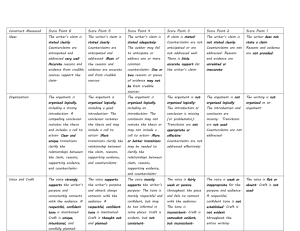Retaliatory Counterclaims: Turning the Table on
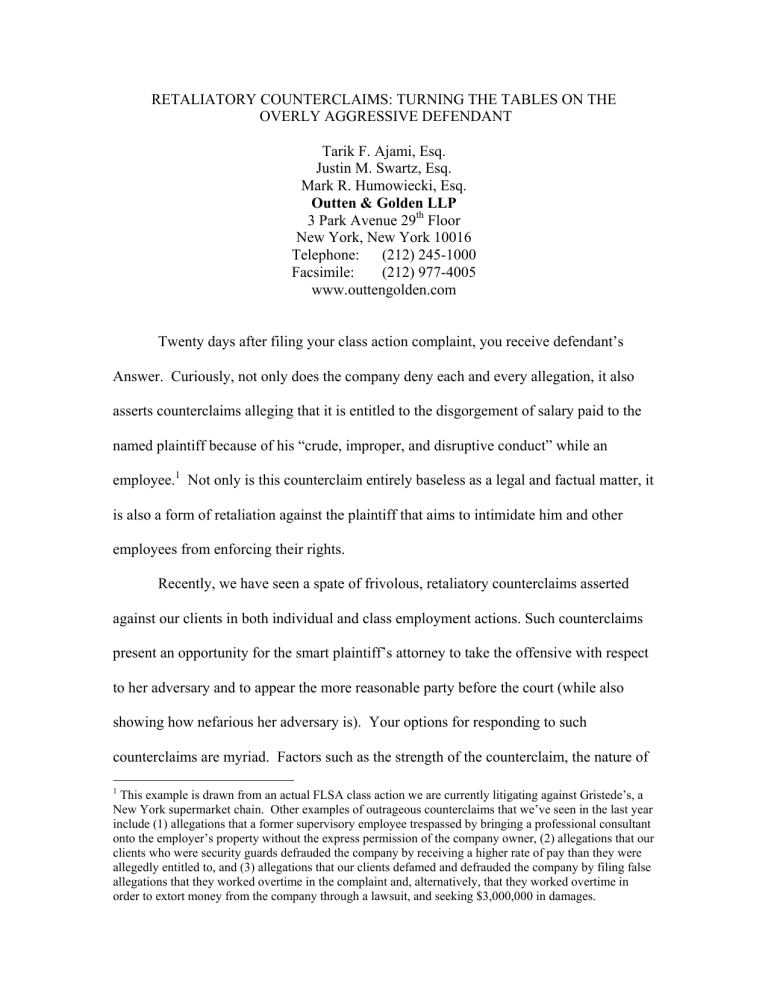
RETALIATORY COUNTERCLAIMS: TURNING THE TABLES ON THE
OVERLY AGGRESSIVE DEFENDANT
Tarik F. Ajami, Esq.
Justin M. Swartz, Esq.
Mark R. Humowiecki, Esq.
Outten & Golden LLP
3 Park Avenue 29 th
Floor
New York, New York 10016 www.outtengolden.com
Twenty days after filing your class action complaint, you receive defendant’s
Answer. Curiously, not only does the company deny each and every allegation, it also asserts counterclaims alleging that it is entitled to the disgorgement of salary paid to the named plaintiff because of his “crude, improper, and disruptive conduct” while an employee.
Not only is this counterclaim entirely baseless as a legal and factual matter, it
is also a form of retaliation against the plaintiff that aims to intimidate him and other employees from enforcing their rights.
Recently, we have seen a spate of frivolous, retaliatory counterclaims asserted against our clients in both individual and class employment actions. Such counterclaims present an opportunity for the smart plaintiff’s attorney to take the offensive with respect to her adversary and to appear the more reasonable party before the court (while also showing how nefarious her adversary is). Your options for responding to such counterclaims are myriad. Factors such as the strength of the counterclaim, the nature of
1
This example is drawn from an actual FLSA class action we are currently litigating against Gristede’s, a
New York supermarket chain. Other examples of outrageous counterclaims that we’ve seen in the last year include (1) allegations that a former supervisory employee trespassed by bringing a professional consultant onto the employer’s property without the express permission of the company owner, (2) allegations that our clients who were security guards defrauded the company by receiving a higher rate of pay than they were allegedly entitled to, and (3) allegations that our clients defamed and defrauded the company by filing false allegations that they worked overtime in the complaint and, alternatively, that they worked overtime in order to extort money from the company through a lawsuit, and seeking $3,000,000 in damages.
the underlying litigation, the actual chilling effect of the retaliation, and the dispositions of the adversary and the judge will dictate the most appropriate strategy.
You may simply amend the complaint to assert a retaliation claim or seek to convince the opposing counsel to withdraw the counterclaims. Alternatively, you may want to aggressively litigate the retaliation from the beginning by moving to dismiss the counterclaims or even seeking to enjoin further retaliation and to impose other measures to repair the chilling effect of the retaliation. This article sets forth the advantages and disadvantages of these different options and the basic legal principles that are common to retaliatory counterclaims no matter what course you choose.
The first step is to recognize that the counterclaims are not only frivolous, but also a form of retaliation. Perhaps it is not entirely surprising that a defendant who has been sued feels defensive and responds by attempting to punish the “ungrateful former employee” and to deter others from taking similar measures. This desire to punish the individual for engaging in protected activity (i.e. filing a lawsuit), and to deter others from acting similarly, is what makes it retaliation. See Brissette v. Franklin County
Sheriff’s Office, 235 F. Supp. 2d 63 (D. Mass. 2003).
The vast majority of employment law statutes explicitly prohibit retaliation. See e.g. 29 U.S.C. 216(a)(3) (FLSA)
; 29 U.S.C. § 623(d) (ADEA); 42 U.S.C. 2000e-3(a)
(Title VII)
; 42 U.S.C. 12203(a) (ADA). Even where there is no explicit ban, courts are
2
The FLSA anti-retaliation provision states: “It shall be unlawful for any person—(3) to discharge or in any other manner discriminate against any employee because such employee has filed any complaint or instituted or caused to be instituted any proceeding under or related to this chapter, or has testified or is about to testify in any such proceeding, or has served or is about to serve on an industry committee.” 29
3
U.S.C. § 215(a).
Title VII’s anti-retaliation provision states: “It shall be an unlawful employment practice for an employer to discriminate against any of his employees or applicants for employment … because he has opposed any practice made an unlawful employment practice by this subchapter, or because he has made a charge, testified, assisted, or participated in any manner in an investigation, proceeding, or hearing under this
likely to find that one is implied, as the Supreme Court did last term in the context of
Title IX. See Jackson v. Birmingham Bd. of Ed ., 125 S. Ct. 1497 (2005). In Jackson, the
Court explained the primacy of retaliation proscriptions to the national goal of eliminating discrimination embodied in Title IX. The same analysis is equally applicable to other employment statutes.
Reporting incidents of discrimination is integral to Title IX enforcement and would be discouraged if retaliation against those who report went unpunished.
Indeed, if retaliation were not prohibited, Title IX’s enforcement scheme would unravel.
Id. at 1508.
Retaliation claims are analyzed using the traditional burden-shifting framework of
McDonnell Douglas Corp. v. Green , 411 U.S. 792 (1973). To prevail, you must show (1) that the individual engaged in a statutorily protected activity, (2) that she suffered an adverse employment action, and (3) that retaliation was a motivating factor in the employer’s decision. See Treglia v. Manlius , 313 F.3d 713, 719 (2d Cir. 2002); Lovejoy-
Wilson v. NOCO Motor Fuel, Inc ., 263 F.3d 208, 223 (2d Cir. 2001). Your client’s lawsuit easily satisfies the statutorily protected activity. As explained below, the act of being sued or having a counterclaim asserted against one satisfies the adverse employment action requirement for purposes of a retaliation claim. The causal connection is straightforward in this type of case, where there is a close temporal connection between the lawsuit and the counterclaim and where the counterclaim is frivolous. “When an employee’s participation in statutorily protected activity is the determining factor in an employer’s decision to take [sic] adverse employment action, subchapter.” 42 U.S.C. 2000e-3(a).
that action is invalid regardless of the employer’s intent.” EEOC v. Bd. of Governors of
State Colleges and Universities , 957 F.2d 424, 428 (7th Cir. 1992).
The goal of anti-retaliation provisions is to “maintain[] unfettered access to statutory remedial mechanisms.” Robinson v. Shell Oil Co.
, 519 U.S. 337 (1997).
Therefore, unlike the underlying discrimination or other employment claim, actionable retaliation is not limited only to adverse changes in the employment relationship, such as reductions in pay or termination. See EEOC v. Die Fliedermaus , 77 F. Supp. 2d 460, 472
(S.D.N.Y. 1999); see also Robinson , 519 U.S. 337 (holding that anti-retaliation provisions apply equally to former employees); Gliatta v. Tectum, Inc.
, 211 F. Supp. 2d
992, 1008 (S.D. Ohio 2002) (retaliation ban applies to conduct beyond traditional employment decisions); c ompare 42 U.S.C. § 2000e-2(a) (discrimination) and 42 U.S.C.
§ 2000e-3(a) (retaliation). Rather, any non-employment retaliation “reasonably likely to deter … protected activity” can constitute proscribed retaliation. See EEOC Compliance
Manual, Section 8: Retaliation (http://www.eeoc.gov/ policy/compliance.html), pp. 8-13,
8-14.
Legal proceedings – including counterclaims – can constitute actionable retaliation if they are filed against an employee in response to the employee asserting statutory workplace rights. See , e.g.
, Jacques v. DiMarzio, Inc.
, 216 F. Supp. 2d 139,
141-43 (E.D.N.Y. 2002) (defendant’s counterclaims found sua sponte to be retaliatory, dismissal and sanctions issued sua sponte ); Gliatta v. Tectum, Inc.
, 211 F. Supp. 2d 992,
1008-09 (counterclaim alleged to be retaliatory) (citing EEOC v. Outback Steakhouse of
Florida, Inc.
, 75 F. Supp. 2d 756 (N.D. Ohio 1999) (same)); Cozzi v. Pepsi-Cola Gen.
Bottlers, Inc.
, No. 96 C 7228, 1997 WL 312048, at *3 (N.D.
Ill.
1997) (state court fraud
lawsuit alleged to be retaliatory); Jones v. Ryder Servs. Corp.
, No. 95 C 4763, 1997 WL
158329, at *5 (N.D. Ill. 1997) (withdrawing workers’ compensation settlement offer following EEOC charge alleged to be retaliatory); Atkinson v. Oliver T. Carr Co.
, Civ.
A.
No.
85-1950, 1986 WL 6997, at *2, 4 (D.D.C. 1986) (complaint to police about employee following EEOC charge alleged to be retaliatory). “[A] lawsuit … may be used by an employer as a powerful instrument of coercion or retaliation” and may dissuade individuals from pursuing their claims. Rosania v. Taco Bell of Am., Inc.
, 303 F. Supp.
878, 885 (N.D. Ohio 2004) (internal quotations omitted).
Even the threat of a lawsuit can constitute an adverse employment action because it is designed to deter the protected activity. In Lovejoy-Wilson v. NOCO Motor Fuel,
Inc.
, the Second Circuit found actionable “adverse action” in the employer’s threat of a lawsuit against an employee who asserted rights under the Americans with Disabilities
Act; the threat “served to ‘intimidate’ or ‘threaten’ her in the assertion of her right to make complaints or file charges under the ADA.” 263 F.3d 208, 223.
Although allegations contained within legal pleadings are protected by an absolute privilege under the law of defamation, the Supreme Court has long recognized that the Constitution does not protect the assertion of frivolous legal claims, and that such action can constitute actionable retaliation. Bill Johnson’s Restaurants,Inc. v. NLRB , 461
U.S. 731 (1983) (holding that the NLRB may enjoin a baseless lawsuit that is brought for retaliatory reasons).
Negotiating the Counterclaims’ Withdrawal
Faced with such retaliatory counterclaims, it will often be preferable to attempt to eliminate them so that they don’t become a sideshow that diverts time, attention and
money from the main show – the client’s wage or discrimination claims. You may simply explain to opposing counsel that the counterclaims are frivolous and retaliatory and give her the opportunity to withdraw them. Once she understands the potential liability and your ability to aggressively litigate the issue, she may quickly seize this opportunity. In one case, opposing counsel explained to us that his client insisted on bringing the counterclaims because he was offended by some specific, non-essential language in the complaint. He offered to withdraw the counterclaims with prejudice if we agreed to amend our complaint to remove that language and not add a retaliation claim.
Asserting a Retaliation Claim
You may also decide that it makes tactical sense to make an issue of the counterclaims by raising a retaliation claim. The introduction of retaliation as an issue may shift the judge’s sympathy in your favor because she may view the counterclaims as a particularly offensive use of the judicial system to intimidate an individual asserting her rights. See Jacques , 216 F. Supp. 2d at 144 (“[G]iven the plaintiff's labile emotional condition and her initial pro se status, the factually unsupported, conclusory lay nature of the counterclaim can only realistically be viewed, as suspected by the Court in its prior decision, as a bad faith retaliatory in terrorem tactic against the plaintiff for bringing her claims to court.”) Particularly when the defendant has already engaged in other forms of retaliation or the underlying claims allege outrageous behavior, an additional example of naked retaliation helps to illustrate the defendant’s capacity for such behavior to both the judge and a jury.
Additionally, your client can recover damages as a result of the retaliation claim.
Depending on the nature of the counterclaim allegations, she may be able to recover for harm to her reputation and emotional distress, as well as the legal costs of defending the counterclaims. There is a circuit split as to whether punitive damages are available for
FLSA retaliation claims. Compare Travis v. Gary Community Mental Health Center,
Inc.
, 921 F.2d 108, 112 (7 th
Cir. 1990) (punitive damages available) with Snapp v.
Unlimited Concepts, Inc.
, 208 F.3d 928, 933 (11 th
Cir. 2000) (not available).
The simplest way to assert the retaliation claim is to either move to amend the complaint to add the claim or, at least in some courts, simply add the claim as part of your reply to the counterclaim. See F.R.C.P. 7(a) (Reply) ; United Magazine Co. v.
Murdoch Magazines Distribution, Inc., 2003 WL 223462 (S.D.N.Y. 2003) (allowing for inclusion of additional claim in reply under F.R.C.P. 15(a)’s liberal amendment standard). Such a strategy allows you to make an issue of the retaliation without holding up discovery by seeking to dismiss the counterclaims or to enjoin the retaliation.
After raising the retaliation claim, you should seek broad discovery regarding the counterclaims. Frequently, they are predicated on some sort of factual misrepresentation; defendants risk destroying their credibility and angering the court by trying to prove these frivolous counterclaims or alternatively by failing to provide proper discovery once the inadequacy of the claim becomes clear. You will often be able to resolve the counterclaim on summary judgment.
Motion to Dismiss the Counterclaims
Where the counterclaims are patently inadequate, you may choose to move to dismiss the counterclaims. This tactic is best reserved for those instances where the
counterclaims are legally insufficient or jurisdictionally defective. If they are valid claims as pled (though completely fabricated as a factual matter), they will likely survive a motion to dismiss.
Many counterclaims may be vulnerable on the grounds of subject matter jurisdiction if the case is filed in federal court. Because most counterclaims sound in tort or contract theories that do not have an independent federal basis for federal jurisdiction, the counterclaim and the underlying federal claim must “derive from a common nucleus of operative fact” for the non-federal claim to fall within supplemental jurisdiction. 28
U.S.C. § 1367(a). In the context of employment law actions, it is not enough that the counterclaim derives from the same employment relationship that gave rise to the federal claims. Klein v. London Star Ltd.
, 26 F. Supp. 2d 689 (S.D.N.Y. 1998) (collecting cases); Spencer v. Banco Real, S.A.
, 623 F. Supp. 1008 (S.D.N.Y. 1985) (counterclaims for torts including trespass insufficiently related to underlying Title VII claims); Hameli v. Nazario , 930 F. Supp. 171, 183 (D. Del. 1996) (claim that employer lacked “good cause” to terminate Plaintiff under state law was not so closely related to Plaintiff’s claim that defendant’s decision to terminate plaintiff violated due process). Rather, the resolution of the claims must depend on the same facts. Goldman Marcus, Inc. v .
Goldman , 2000 WL 297169 (S.D.N.Y. 2000) .
By moving to dismiss the claims, you immediately bring defendant’s retaliatory behavior to light before the judge. However, you also risk sidetracking the case as defendants fight to protect their counterclaims. The steps to which unscrupulous defendants and their counsel will go to keep counterclaims from being dismissed can be astounding. In the case involving the manager who was counterclaimed for trespass for
bringing a consultant on to the employer’s property to perform professional services
(footnote 1), we moved to dismiss for lack of supplemental jurisdiction, among other reasons. Defendants responded by arguing that the claims constituted an after-acquired evidence defense and therefore were part of the same case or controversy for purposes of
28 U.S.C. § 1367. When we submitted evidence showing that the incident in question occurred 14 months before the termination and that the employer was aware of it and had in fact discussed it with our client at that time, defendants submitted a series of vague and misleading affidavits denying those facts to try to create a fact question. While defendant’s extreme measures to protect their counterclaims are destroying their credibility with respect to the remainder of the case, their strategy has also consumed large amounts of our time and money on a side issue, which is clearly part of their strategy.
Temporary Restraining Order/Preliminary Injunction
Where the counterclaims pose a real threat to participation in the lawsuit, particularly in a class or collective action context, you may wish to seek immediate injunctive relief from the court. The risk that defendant’s aggressive retaliation will deter individuals from either joining the lawsuit or cooperating in its prosecution justifies the court taking action to enjoin future retaliation and to provide corrective action to mollify the deterrent impact of the counterclaims. The standard test for injunctive relief applies.
You can readily show irreparable harm. “[I]mproper conduct for which monetary remedies cannot provide adequate compensation suffices to establish irreparable harm.”
Paulsen v. County of Nassau , 925 F.2d 65, 68 (2d Cir. 1991). The effects of frivolous counterclaims, designed by definition only to retaliate, chill, and intimidate, clearly
wreak irreparable harm on the plaintiffs and on other employees who would be deterred from asserting their employment rights. The Second Circuit has held that the potential of retaliation to undermine enforcement of the law by deterring “other employees … from protecting their rights … or from providing testimony for the plaintiff … may be found to constitute irreparable injury.” Holt v. Cont’l Group, Inc.
, 708 F.2d 87, 91 (2d Cir. 1993)
(involving Title VII claims).
The risk of irreparable harm is particularly acute in the context of FLSA collective actions. Unlike traditional Rule 23 class actions in which the statute of limitations is triggered by the filing of the lawsuit for all class members, the FLSA statute of limitations continues running on each employee’s claims until the individual affirmatively files with the court a consent to sue. Any deterrent effect, even if it delays participation in the suit for only several months, can effectively eliminate claims by scaring off potential plaintiffs from opting into the lawsuit.
Adopting this rationale, courts have imposed preliminary injunctions to stop employers from retaliating against plaintiffs and thereby deterring participation in the enforcement of the FLSA. See, e.g., Centeno-Bernuy v. Perry , 302 F. Supp. 2d 128, 135
(W.D.N.Y. 2003) (citing Holt , 708 F.2d at 91, and ordering preliminary injunction of retaliation against FLSA plaintiffs); OTR Drivers at Topeka Frito-Lay, Inc.’s Distribution
Center v. Frito-Lay, Inc.
, Civ. A. No. 91-4024-S, 1991 WL 49758, at *1 (D. Kan. 1991)
(ordering preliminary injunction against “threatening, harassing or intimidating plaintiffs because of their participation in this (FLSA) suit . . . .”). “Unchecked retaliation, no matter its form, subverts the purpose of the FLSA . . . and other federal employment laws.” Centeno-Bernuy , 302 F. Supp. 2d at 135.
Importantly, you do not need to prove the retaliation claim with certainty in order to justify injunctive relief. Plaintiffs “need not establish a ‘clear’ or ‘substantial’ likelihood of success because the injunctive relief [sought] now will not ‘render a trial on the merits largely or partly meaningless.’” Reynolds v. Giuliani , 35 F. Supp. 2d 331, 334
(S.D.N.Y. 1999) (quoting Tom Doherty Assocs.
, 60 F.3d at 34; Eng v. Smith , 849 F.2d 80,
82 (2d Cir. 1988)). “Plaintiffs ‘need only make a showing that the probability of
[plaintiffs] prevailing is better than fifty percent. There may remain considerable room for doubt.’” Id.
In formulating injunctive relief, the court’s focus is on how to undo the potential deterrent effect in the least intrusive way. An injunction should likely include both restrictions on further retaliatory acts directed towards putative class members and the issuance of a corrective notice to the putative class to explain the protection against retaliation and the right to participate in the lawsuit. A corrective notice that “levels the playing field” is appropriate to prevent the defendant from benefiting from its improper acts. See Haffer v. Temple University , 115 F.R.D. 506, 512 (E.D. Pa. 1987).
Additional Sanctions
Courts may also order payment of attorneys’ fees and costs, penalties to the court, or other sanctions imposed on the party and/or its attorney for asserting frivolous counterclaims. Rule 11 provides for sanctions if, after notice and a reasonable opportunity to respond, the court determines that the counterclaim or other papers (1) were presented for an “improper purpose, such as to harass or to cause unnecessary delay or needless increase in the cost of litigation,” (2) are legally frivolous, or (3) as a factual matter lack any evidentiary support. F.R.C.P. 11(b) & (c). The court in Jacques imposed
a $1,000 fine on defense counsel, under Rule 11, for bringing retaliatory and frivolous counterclaims.
Section 1927 of Title 28 of the United States Code provides that “[a]ny attorney . . . who so multiplies the proceedings in any case unreasonably and vexatiously may be required by the court to satisfy personally the excess costs, expenses, and attorneys’ fees reasonably incurred because of such conduct.” The purpose of Section
1927 is “to deter unnecessary delays in litigation.” United States v. Int’l Bhd. of
Teamsters , 948 F.2d 1338, 1345 (2d Cir. 1991) (internal quotes omitted).
Although a finding of “bad faith” is required for the imposition of sanctions under
Section 1927, bad faith will be inferred by a court “when the attorney’s actions are so completely without merit as to require the conclusion that they must have been undertaken for some improper purpose . . . .” ACLI Gov’t Sec., Inc. v. Rhoades , 907 F.
Supp. 66, 68 (S.D.N.Y. 1995) (quoting Keller v. Mobil Corp.
, 55 F.3d 94, 99 (2d Cir.
1995)). Bad faith conduct can be inferred where a party pursues frivolous arguments.
Browning Debenture Holders’ Comm v. DASA Corp.
, 560 F.2d 1078, 1088 (2d Cir.
1977); Sam & Mary Housing Corp. v. New York , 632 F. Supp. 1448 (S.D.N.Y. 1986)
(bad faith can be inferred where action is utterly groundless).
Conclusion
The overly aggressive defendant risks a great deal when it asserts frivolous counterclaims. Rather than being put on the defensive or diverted from your underlying claims by the counterclaims, you can recast the issue as one of illegal retaliation and use it to your advantage from the start of the litigation.


